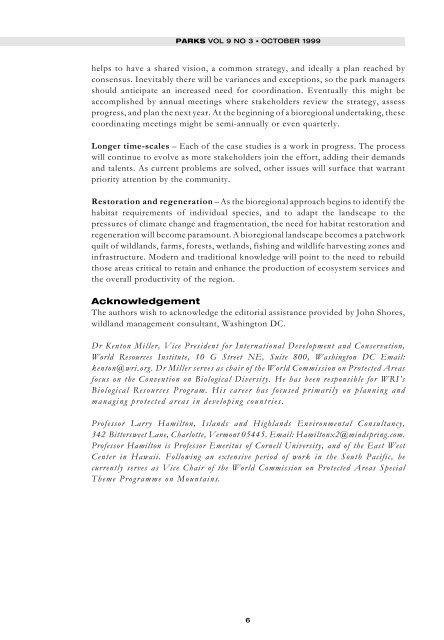Parks - IUCN
Parks - IUCN
Parks - IUCN
You also want an ePaper? Increase the reach of your titles
YUMPU automatically turns print PDFs into web optimized ePapers that Google loves.
PARKS VOL 9 NO 3 • OCTOBER 1999<br />
helps to have a shared vision, a common strategy, and ideally a plan reached by<br />
consensus. Inevitably there will be variances and exceptions, so the park managers<br />
should anticipate an increased need for coordination. Eventually this might be<br />
accomplished by annual meetings where stakeholders review the strategy, assess<br />
progress, and plan the next year. At the beginning of a bioregional undertaking, these<br />
coordinating meetings might be semi-annually or even quarterly.<br />
Longer time-scales – Each of the case studies is a work in progress. The process<br />
will continue to evolve as more stakeholders join the effort, adding their demands<br />
and talents. As current problems are solved, other issues will surface that warrant<br />
priority attention by the community.<br />
Restoration and regeneration – As the bioregional approach begins to identify the<br />
habitat requirements of individual species, and to adapt the landscape to the<br />
pressures of climate change and fragmentation, the need for habitat restoration and<br />
regeneration will become paramount. A bioregional landscape becomes a patchwork<br />
quilt of wildlands, farms, forests, wetlands, fishing and wildlife harvesting zones and<br />
infrastructure. Modern and traditional knowledge will point to the need to rebuild<br />
those areas critical to retain and enhance the production of ecosystem services and<br />
the overall productivity of the region.<br />
Acknowledgement<br />
The authors wish to acknowledge the editorial assistance provided by John Shores,<br />
wildland management consultant, Washington DC.<br />
Dr Kenton Miller, Vice President for International Development and Conservation,<br />
World Resources Institute, 10 G Street NE, Suite 800, Washington DC Email:<br />
kenton@wri.org. Dr Miller serves as chair of the World Commission on Protected Areas<br />
focus on the Convention on Biological Diversity. He has been responsible for WRI’s<br />
Biological Resources Program. His career has focused primarily on planning and<br />
managing protected areas in developing countries.<br />
Professor Larry Hamilton, Islands and Highlands Environmental Consultancy,<br />
342 Bittersweet Lane, Charlotte, Vermont 05445. Email: Hamiltonx2@mindspring.com.<br />
Professor Hamilton is Professor Emeritus of Cornell University, and of the East West<br />
Center in Hawaii. Following an extensive period of work in the South Pacific, he<br />
currently serves as Vice Chair of the World Commission on Protected Areas Special<br />
Theme Programme on Mountains.<br />
6

















